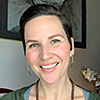In Chinese medicine, one of the first diagnostic principles we learn is to differentiate the root from the branch. When we begin to treat the root, we see transformative shifts occur in the patient. Looking another step deeper, we see the soil, the deepest layer; this unseen and usually unnameable force that sets us up to create and experience certain things in our lives. It's the unseeable pattern that sets up the visible and nameable string of events that eventually leads to the presentation at hand.
The Root – Hun Disturbance
The spirit of the hun's responsibility is to help turn the insight of our shen into ideas and plans that we can materialize into reality. It's our clear vision, clear direction, seeing reality clearly, and our capacity for justice and benevolence. The overarching theme of the hun is helping us to find our true path, quite literally looking at the question of, "Who am I and where am I going?"
Repressing emotions is a common contributing factor of a hun disturbance. When this happens, we also see physical symptoms like digestive upset, headaches and fatigue that come on during stressful times. Avoiding and repressing emotions only makes them stronger, saving them for a later date, when we often boil over as we can no longer control the container we've hidden them in. Other contributing causes of a hun disturbance include early exposure to alcoholism and violence during childhood, lack of guidance or direction from caregivers, substance abuse (particularly alcohol and marijuana), anemia, and environmental toxin exposures.
Three Clusters of Presenting Symptoms
A hun disturbance presents as three clusters of symptoms: deficient, excess and mixed patterns. I will detail the excess and deficient patterns below; a mixed pattern is simply a mix of both, usually presenting as flip-flopping from one pattern to the other and back again.
The deficient presentation might be overly apathetic, depressed with a generally low affect and demeanor. The patient is shy, timid, confused and doesn't show emotions easily or regularly. They may even find it difficult to name or tell you what emotions they are feeling at any given time. They are too weak to even start a project, much less complete one.
An excess hun disturbance presents with a heightened anger response. It's a "me against the world" mentality, enraged with righteous indignation at the world, the government and anyone or anything they perceive as unjust in the world. This person may often have bouts of extreme emotions due to repressing emotions chronically. They bottle emotions until a small stressor "sets them off"; then an explosion of emotion wells up from within them.
On a deeper level, this person feels stuck and trapped, feeling that it doesn't matter what they do – they will always be stuck. They lack an awareness and ability to truly take control and responsibility of their life. This person has an extremely difficult time seeing reality clearly, as they are overwhelmed by the emotion at hand or the task of burying it.
This pattern is the one I see most often associated with pandemic denial, rebellion, conspiracy theorists and angry "Karens"; it's actually kind of a beautifully poetic way of looking at the inner workings of this type of person.
The Soil: A Crisis of Identity
"When I let go of what I am, I become what I might be." – Lao Tzu
As I've watched people panic over haircuts during the pandemic, I've noticed something: This isn't about the haircuts at all. This pandemic has highlighted a crisis of identity as we've come face to face with ourselves in a way we never have before. It has raised some deeper questions: What is my purpose? Who am I really?
Being stripped of our common routines or being "forced" to wear a mask, is shining a huge spotlight on these attachments of our identity as our body, and highlights the question: "Who am I if I am not my body?"
This pandemic has been a difficult process for everyone. It's uprooted our beliefs, views of reality, relationships and so much more. It's forced us to question our identity and face our mortality in a way we haven't before. For many, there have been significant losses: finances, jobs ... life. Having coping mechanisms is a necessary element to getting through this trying time, but if we find ourselves feeling increasingly unbearable, angry, destroying our relationships, or just constantly uncomfortable, at some point we may need to look below the branch.
A Path Toward Healing and Transformation
Healing the hun requires learning how to access, feel and process our emotions, often best accomplished with a licensed psychotherapist. Developing a self-reflection practice like meditation or journaling will help to get in touch with those emotions and experiences we have. We may also need to directly work with the liver, be it with herbs and acupuncture, or a more in-depth rehabilitation program if substance abuse is a factor.
Acupuncture treatments can help people release attachments and beliefs around our false sense of self and the valences we carry. It's this kind of inner work that needs to be addressed in order to finally be at peace with what is, surrender to change, accept a difficult and scary reality (like a pandemic), and have a sense of purpose that sustains beyond coping mechanisms.
This is, of course, a process, not a one-time fix or even an easy one. It takes a great deal of inner reflection and awareness. The path toward healing, toward acceptance and toward experiencing more peace in our lives is there – we just have to choose to walk it, and help our patients do the same.
Click here for more information about Kim Peirano, DACM, LAc.




